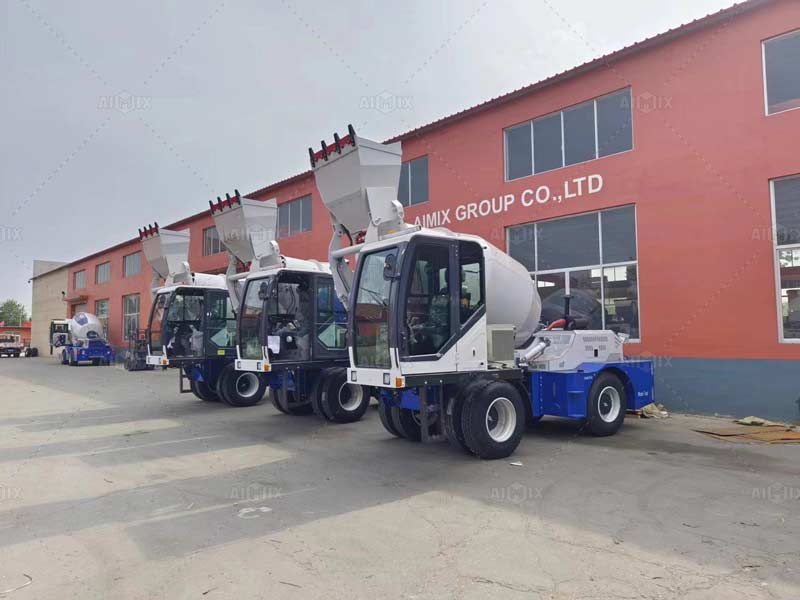


Discover how a 4.0 m³ self loading concrete mixer truck with a concrete pump delivers 100 m³/day efficiently for remote island projects.
Construction on remote islands brings challenges that mainland projects rarely encounter. High transportation costs, limited labor availability, and unpredictable material deliveries make traditional concrete supply methods inefficient. Contractors often ask: can a 4.0 m³ self loaded concrete mixer with a concrete pump handle 100 m³/day while remaining cost-effective? This article explores the answer from practical and financial perspectives.
A self loading mixer truck integrates loading, weighing, mixing, transporting, and discharging in one machine. Each batch produces 4.0 m³ of fresh concrete. With a standard mixing cycle of 15 minutes, it delivers approximately 16 m³ per hour (4 batches × 4 m³). Over a typical working day, it can exceed 100 m³/day, meeting project requirements efficiently.
Unlike traditional setups that require a central batching plant and multiple transit mixers, one self loading mixer reduces equipment footprint, fuel consumption, and labor. Its mobility allows contractors to operate in confined areas, rough terrains, and multiple pour locations without additional logistics.
Concrete placement is often the bottleneck in island construction. Narrow paths, steep slopes, and high-rise structures make manual handling inefficient. By integrating a concrete pump, the carmixer can deliver concrete directly to the pouring site, saving time and manpower.
This combination ensures faster placement, precise pouring, and minimal waste. Contractors no longer need separate pumps or cranes. The result: a streamlined workflow that keeps the project on schedule and reduces overall operational costs.
A single truck producing 16 m³/hour can meet 100 m³/day demand in just 6–7 hours. The remaining time covers maintenance, refueling, or handling unexpected delays. The continuous mixing and pumping workflow eliminates downtime caused by waiting for multiple machines, which is especially valuable in island projects where resources are limited.
The self loading mixer truck is versatile. On remote islands, it can serve multiple project types:
This adaptability means the same truck can be reused across different projects, maximizing return on investment and reducing the need for additional equipment purchases.
On a small island project, a contractor used a 4.0 m³ self loading mixer with pump to pour 120 m³ of concrete for a residential complex. The truck worked 7.5 hours, completing all pours without external batching plant support. Labor costs dropped by 40%, and material waste was reduced by 15% due to precise pumping.
This real-world example illustrates that one integrated unit can handle daily demands efficiently while reducing costs and improving project quality.
Financially, a self loading mixer truck is a smart choice for isolated projects. Consider the following:
Compared to renting a batching plant plus transit mixers and separate pumps, the self loading mixer reduces initial investment and ongoing costs. Maintenance is simpler, spare parts are easier to manage, and operational efficiency is higher.
In a real island project, every hour counts. The 4.0 m³ self loading mixer truck with pump allows contractors to respond to changing site conditions immediately. If a foundation area needs urgent pouring, the truck can move directly without waiting for multiple machines. This reduces idle time, accelerates construction, and ensures that project milestones are met reliably. Real-time adaptability is especially valuable when weather or tide schedules affect construction on islands.
Beyond immediate efficiency, investing in a self loading mixer truck with a concrete pump offers strong long-term benefits. The truck can serve multiple projects over several years, reducing the need for additional equipment. Its durability and low maintenance cost further enhance return on investment. Contractors also save on labor and transport expenses, making the equipment a strategic asset that continues to pay off throughout multiple construction cycles.
Q1: Can a single 4.0 m³ truck meet daily demand?
A: Yes. With 16 m³/hour output, one truck can handle 100–120 m³/day efficiently.
Q2: Is the equipment difficult to operate?
A: AIMIX mixers are user-friendly with simple controls. Training is provided, ensuring operators quickly become proficient.
Q3: How does it perform on rough island terrain?
A: Designed for mobility, with high ground clearance, robust tires, and stability on uneven roads.
To ensure continuous performance, contractors should follow simple maintenance routines:
These practices extend equipment lifespan and minimize downtime, critical in remote locations where service access is limited.
For remote island projects with 100 m³/day concrete demand, a 4.0 m³ self loading concrete mixer truck with a concrete pump is efficient, versatile, and cost-effective. It integrates production and placement, reduces labor, improves safety, and maintains high-quality concrete output.
AIMIX designs self loading mixers with pump integration for real-world challenges. Our trucks are durable, easy to operate, and backed by local service teams. We help contractors save costs, reduce operational complexity, and maintain steady project progress. Whether you are pouring foundations, residential floors, or port facilities, AIMIX equipment ensures reliability and efficiency.
Take control of your remote island construction projects. Contact AIMIX today to discover how our self loading concrete mixer trucks with concrete pumps can deliver concrete efficiently, safely, and cost-effectively.
